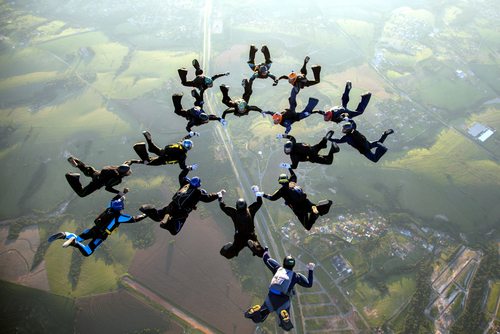When we think of “team building” too often we think of awkward training sessions with requisite icebreaker activities, including, perhaps, the ever-unpopular “trust fall.” But team building activities are a necessary component of creating the kind of collegial and positive workplace climate that establishes the trust and camaraderie your working teams and whole staff need to work effectively. Re-framing our approach to team building leads to greater employee investment in the process and the organization. Invested, happy employees keep clients and customers invested and happy.
The Big Stuff: Beyond Icebreakers
Icebreakers in meetings and training sessions are a good way to introduce unfamiliar team members to one another, but they can feel forced. We’ve all been part of the get-to-know-you roundtable games that asked us to scramble for something interesting about ourselves.
For a more organic approach, Tammie Plouffe at Harvard Business Review suggests talking about photography, tapping into our human instincts for visual stimulation to focus on goal-setting and create a productive working environment while facilitating social connection.
Informal construction challenges are another popular choice, also allowing social interaction as team members work toward a common goal and engage in creative problem solving. Word games or even classic board games are another way for team members to learn one another’s communication styles and improve communication skills in a relaxed, low-stakes setting.
For large-scale team building activities outside the office, the options are really only limited by budget and finding venues that can accommodate the desired numbers. These possibilities can range from the standard social at a bar, to taking a class together, to flash mobs, to simulated sumo wrestling.
The Small Stuff: Consistency
We don’t need a lot of bells and whistles to build more cohesive staff and working teams. We do need a consistent and integrated approach to team building. Team building isn’t just a single activity or event that happens on one or a few days a year, it should be part of the fabric of the office culture. Weekly or monthly lunches harness the simple act of breaking bread to bring people together (never underestimate the power of food). Regular mentoring sessions or other social events also integrate team building into the regular schedule. Holidays provide extra chances to bring colleagues together. Just this week, The Records Company hosted a staff Halloween costume contest. Many offices host an annual holiday party, but some are using that time to combine communication, problem solving, and fun through service projects. Once you get the team-building ball rolling, the key is to keep it rolling.
Get Feedback
A surefire way to make sure your team building efforts are hitting the mark is to ask them. Solicit honest feedback on activities you’ve done, and ask employees what kinds of activities they might like to do in the future. Ask what might help them build the skills and connections they need. Let them take the lead on planning future activities, which can build camaraderie in itself.
